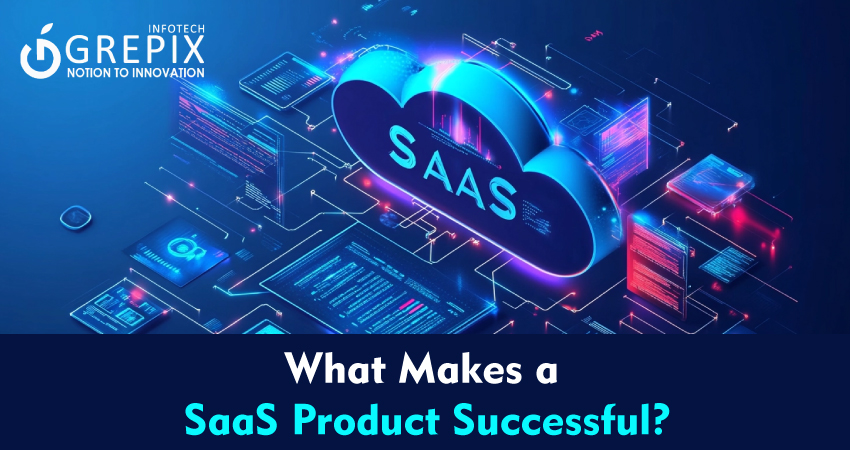What Makes a SaaS Product Successful?
The world of SaaS has come a long way from the early days of subscription-only models and clunky interfaces. Today’s users expect more for less, demand lightning-fast support, and want to be up and running with minimal help. Pricing models have shifted from fixed tiers to pay as you grow. The rise of mobile first users has also nudged developers toward building sleek, responsive SaaS mobile apps. SaaS is no longer about just solving problems. It’s about doing it intuitively, beautifully, and at scale.
So, what really separates a good SaaS product from a wildly successful one? Let’s break it down.
A successful SaaS product in 2025 isn’t built on code alone. It thrives on user empathy, speed, and simplicity. Whether it’s your interface, your onboarding flow, or your analytics dashboard, each element must aim to create value quickly and effortlessly. This post explored how trends like intuitive UI/UX, built-in analytics, and self-service onboarding are shaping modern SaaS. Global examples like Notion, Zoom, and Calendly prove that user-focused SaaS wins every time.So, if you’re venturing into SaaS app development, keep your focus on experience, not just features.
UI/UX Trends: More Than Just a Pretty Face
Design isn’t just about looks. A product that’s beautiful but hard to navigate is like a sports car with no steering wheel. Great user interfaces are clean, accessible, and functional. But great user experience goes deeper.
Key Elements of Winning UI/UX:
- Clarity over cleverness: People prefer clear labels and simple layouts. Dropbox’s clean interface is a classic example.
- Onboarding flows: Think of Canva’s walkthroughs. They guide users naturally without overwhelming them.
- Accessibility: Making features usable for everyone, including users with disabilities.
- Dark mode and personalization: Letting users tweak the look and feel adds to comfort.
Global Example:
Take Notion. Its rise wasn’t just due to flexible features. It offered minimal design, fast loading, and drag-and-drop components that felt like second nature. That’s user-focused SaaS at its best.
Why It Matters:
In 2025 and beyond, attention spans are short and competition is fierce. First impressions come from how your app looks and feels. SaaS app development must prioritize intuitive UI/UX to avoid churn.
Embedded Analytics: Data Where You Need It
Gone are the days when users had to export data to Excel and build pivot tables. Modern SaaS users want insights at their fingertips.
What Are Embedded Analytics?
These are analytics capabilities integrated directly into your SaaS interface. Think charts, heatmaps, usage stats, or predictive dashboards that are part of the app experience itself.
Benefits for Users:
- Saves time by reducing the need to toggle between tools
- Provides real-time insights without manual work
- Helps make smarter decisions instantly
Global Example:
Look at HubSpot. Its built-in reporting dashboard helps users track campaign performance, sales pipelines, and customer engagement without ever leaving the platform.
Benefits for You (the Developer):
- Boosts engagement by making your product more sticky
- Adds perceived value, allowing for premium pricing
- Helps with upsells by showing ROI clearly
SaaS Trends 2025 Note:
According to Gartner, by 2025, over 75% of B2B SaaS products will include embedded analytics as a standard feature. This isn’t optional anymore. It’s a must-have.
Self-Serve Onboarding: Let Me Figure It Out
People today hate waiting. They’d rather figure things out on their own than deal with sales calls or support tickets. That’s why self-serve onboarding is a game changer.
Also Read: "SaaS Vs. In-House Vs. Clone Software - Which One Should You Choose For Your Business?"
What Makes Great Self-Onboarding?
- Interactive product tours: Tools like WalkMe or Userpilot guide users with prompts.
- In-app checklists: These provide a sense of progress.
- Instant setup: Fewer fields, smarter defaults, and automation.
- Help centers and video tutorials: Always accessible support.
Global Example:
Zoom’s onboarding is smooth. A new user can sign up, install the client, host a meeting, and invite guests within minutes. No long tutorials. No salesperson required.
Why It’s Important:
- Reduces friction
- Increases activation rate
- Saves money on customer support
Whether you’re building a SaaS mobile app or a desktop dashboard, make sure the user can get value without human hand-holding.
Other Must-Haves for SaaS Success
Let’s not forget some of the other things that help SaaS products thrive.
1 Scalability
Your tech stack should grow with your user base. That means using microservices, cloud platforms like AWS or Azure, and database solutions like MongoDB or PostgreSQL.
2 Security and Compliance
Data breaches can ruin reputations. Be sure your app complies with GDPR, CCPA, and local laws. Use end-to-end encryption and secure payment gateways.
3 Customer Feedback Loops
Use in-app surveys, feedback widgets, and NPS (Net Promoter Score) tools to hear from users regularly. Tools like Hotjar, Intercom, and Typeform make this easy.
4 Rapid Iteration and Testing
Ship fast, fail faster, fix quickly. Use A/B testing, feature flags, and agile development to adapt quickly.
5 Transparent Pricing Models
Users don’t like surprises. Offer clear pricing tiers, free trials, or freemium models with visible upgrade paths.
6 Cross-Platform Support
In 2025, a product that only works on one device is a dinosaur. Responsive design and mobile compatibility are crucial. Users expect to switch from desktop to mobile without friction.
Real-World Anecdote: From Side Project to SaaS Star
Consider the story of Calendly. It started as a one-man project solving a common problem scheduling meetings without emails back and forth. The interface was simple, onboarding was almost instant, and it solved a real pain point.
Calendly didn’t try to be everything for everyone. Instead, it excelled in one thing and then expanded. That’s the core principle behind many successful SaaS products today.
Conclusion
The SaaS landscape has become both crowded and exciting. What separates the winners from the rest is how deeply they understand their users. Success is not just about throwing features into an app but crafting an experience that feels effortless and empowering.
Whether you’re creating a SaaS mobile app or a robust web platform, the secret sauce lies in thoughtful design, actionable insights, and self-sufficiency. The rise of embedded analytics shows us that users want to see the value in real time. The demand for self-serve onboarding reveals a culture that prioritizes independence. And the emphasis on sleek, usable design proves that people judge books by their covers.
As SaaS trends 2025 continue to unfold, remember one thing: the most successful products are those that never stop evolving based on what real users actually need. Listen, adapt, and innovate—that’s the winning formula.
FAQs
1. What is user-focused SaaS?
It refers to SaaS products designed with the end user in mind, emphasizing intuitive design, personalization, and fast onboarding.
2. Why is embedded analytics important for SaaS in 2025?
Because users demand real-time insights. Embedded analytics helps users make smarter decisions without switching tools.
3. How does self-serve onboarding benefit SaaS companies?
It reduces support costs, improves activation rates, and increases user satisfaction.
4. What makes a good SaaS mobile app?
Fast loading, offline access, responsive design, and simplified UX tailored for smaller screens.
5. Are there free tools to add analytics or onboarding?
Yes. Tools like Mixpanel, Hotjar, and Userpilot offer free plans for startups or MVPs.
Looking to turn your app idea into reality? Get in touch with Grepix Infotech for scalable and ready-to-launch solutions. Contact Us.







